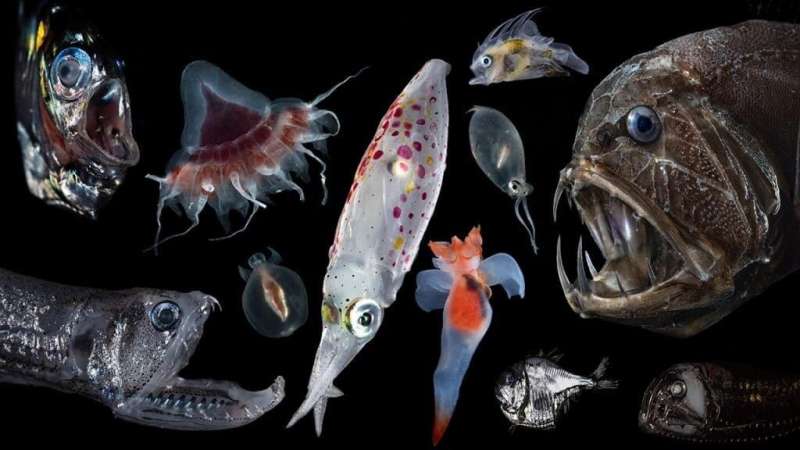Ocean twilight zone scientists tackle the challenge of bringing light into darkness

Oceanographers studying creatures in the ocean twilight zone are facing an optical dilemma. They need to observe the fish in order to study them, but at ocean depths of 200 meters and beyond, there's very little natural light trickling down from the surface. This means that submersibles developed to image and track these animals need to be equipped with lights that can illuminate the animals—and do so without scaring them off.
"If we want to get down there and see the animals in their natural habitats, we need to shine lights on them," said Joel Llopiz, a biologist at Woods Hole Oceanographic Institution. "But we're not sure yet how they'll respond to different types of lights."
Lighting up a dimly-lit world
Twilight zone fish spend most of their lives bathed in blue-green light. The light starts off as part of a rainbow of wavelengths as sunlight hits ocean's surface, but unlike other colors which get absorbed by seawater before making it to the twilight zone, blue-green penetrates well into that region. The environment is so dimly lit, however, that fish have had to anatomically adapt with larger eyes and higher levels of visual pigment in order to see.
Using white lighting in the twilight zone, according to Llopiz, would provide the widest field of view for a submersible and enable the best image quality. But for these light-starved animals, the transition from near-darkness to brightness could startle them, similar to the sensory overload we experience when we walk out of a movie theater during the day into bright sunlight.
In some cases, light attracts animals. That may be useful in certain situations, but it can present a biased view of which animals are present.
Red light, on the other hand, may not be noticeable to OTZ creatures at all—spectral sensitivity studies on fish and invertebrates have shown that many are colorblind to red. The issue with red light, however, is that it doesn't penetrate well through seawater, so the number of bristlemouths, jellyfish, and other mesopelagic animals that can be observed at one time is limited.
Achieving the right balance
Ocean twilight zone scientists and engineers understand these tradeoffs and are working toward a lighting solution that balances exceptional imagery and stealthiness. They've been testing out two LED arrays—one with warm white lights, and the other with deep red lights—to determine which is more effective in imaging twilight zone animals.
"We thought very carefully about the color of our lights," said WHOI senior scientist Dana Yoerger, the lead designer of a new autonomous submersible for studying the twilight zone—Mesobot—that will follow individual animals through the sunless waters. "Red and white is the 'palette' we're using, in conjunction with stereo cameras for locating target animals and 4K video to capture what they're doing."
Yoerger says the LEDs can be cycled through a range of combinations as the vehicle hovers to provide optimum lighting. "Mesobot has a lot of endurance, "so we can drive it around for long periods of time to try out different lighting schemes," he said "We can shift from using white to red lights with varying levels of power and intensity. Ultimately, the question is, will we see more animals with red light or white light at the same depths and time of day?"
Stalking a siphonophore
Red lighting has already shown promise for tracking twilight zone fish. "The use of red lighting in the ocean is new to us," said Jonathan Howland, a principal engineer at WHOI, "and we've had concerns that the attenuation through seawater and reduced camera sensitivity might be a problem. But during recent tests with our colleagues from the Monterey Bay Aquarium Research Institute (MBARI) and Stanford University, we used dim red lights and after adjusting camera gain and exposure, we happily tracked, for varying amount of time, a ctenophore, an abandoned larvacean home, and a phronima in a salp barrel."
Red lighting also helped image a siphonophore—a cousin of the Portuguese man-of-war—for more than five hours. The animal moved in sporadic bursts, according to Howland, and performed arabesque-like moves as it plunged 150 meters (492 feet) throughout the course of the day.
"We learned a great deal about what kinds of parameters work for tracking animals, as opposed to 'pretty picture' imaging," he said.
No one is ruling out the use of white light at this point, but having early success with the red LEDs is a big step forward, according to the researchers. They plan to conduct preliminary ocean tests of the new lighting system on Mesobot this fall.
"We designed Mesobot to be able to hover and move as unobtrusively as possible in order to observe and image the animals without changing their behavior," said Yoerger. "The lights are just as important in achieving this goal as some of vehicle's mechanical components, like the thrusters and passive ballasting system which were designed with stealthiness in mind."
Provided by Woods Hole Oceanographic Institution




















